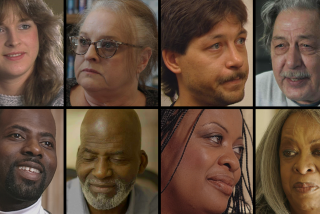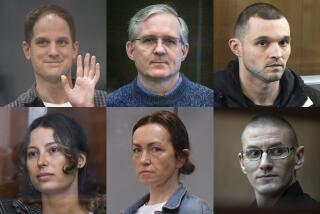Two American Families in Gorbachev’s Moscow...
- Share via
Mikhail Gorbachev may be having his difficulties reviving the moribund Soviet economy, but glasnost and perestroika are already revving up the American publishing industry. Judging by these two highly impressionistic early entries, the books produced will tantalize with their questions but provide few answers.
Both “Back in the U.S.S.R.” and “Moscow Spring” represent joint efforts: the first by the entire Schecter family, and the second by the husband-and-wife Taubman team. Both sets of authors draw upon earlier experiences in the Soviet Union as jumping-off points for their descriptions of the current situation, providing a sense of continuity and contrasts. But their accounts diverge not only stylistically but in their assumptions about the nature of the Soviet system and the Gorbachev experiment.
Jerrold Schecter, his wife Leona and five children lived in Moscow from 1968 to 1970, when he served as bureau chief for Time-Life. They produced a book afterward, “An American Family in Moscow,” which recounted their experiences, including the children’s adjustment to Russian schools. With the addition of three spouses of the now grown children, the Schecters spent 10 weeks in Moscow in 1987 to film a television documentary about their return and to gather material for their new book.
William Taubman teaches political science at Amherst College, while Jane teaches Russian there. (In the spirit of full disclosure, let it be noted that Bill served as one of this reviewer’s senior thesis advisers.) They visited the Soviet Union repeatedly in the past, and they spent the first half of 1988 on an exchange program in Moscow.
The subject of these books is more glasnost than perestroika , since the intellectual battles of the former were far more visible in 1987 and 1988 than any concrete manifestations of the latter. “Moscow in the spring of 1988 was like one large seminar where, miracle of miracles, everyone had done the reading,” the Taubmans observe. Buoyed by the excitement of witnessing and often participating in unprecedented discussions of formerly taboo topics, they state their conclusion at the outset that Gorbachev’s changes “may prove to be more revolutionary than the Russian Revolution itself.”
While impressed with the willingness of many Russians to speak more freely, the Schecters take a more skeptical view. They note the continuing presence of the KGB, not only in its headquarters but also in the daily routine. They offer the telling image of warehouses “spilling over” with books that cannot be distributed because they do not reflect the new party line, and pick up the threats leveled by their official watchdog against Russians interviewed for the film project lest they voice overly critical opinions. “Living with its limitations we wondered whether glasnost was nothing more than a little fresh air injected to save the one-party system from its internal dry rot,” they write.
For all their enthusiasm, the Taubmans are not immune to such doubts either. At times, they claim they have to remind themselves that they are in the Soviet Union, not a free-wheeling democracy; at others, they are depressed by the realization of how far the reform process has to go before it can be reasonably expected to stick. They find reason to brood about “the fatalism and passivity” of much of the population, which divides them from the pro-reform intellectuals. And they were chilled by the silence that followed the publication of the famous letter from Nina Andreyeva, a Leningrad chemistry teacher who defended the old order, including the Stalinst legacy. Until Pravda printed a rebuttal, many people suddenly rediscovered their fear.
The authors also betray signs of nervousness, revealing attitudes typical of many Westerners. Bill Taubman confesses that “as a guest of the Soviet Union and a Sovietologist who depended on frequent trips to the U.S.S.R. for access to key sources, he had gone out of his way to be polite. He had never said anything he did not believe, but he had not said everything he did.” While he maintains that his behavior changed in the age of glasnost , this admission of self-censorship is at once disarming in its frankness and troubling in its implications.
As a journalist, Schecter had his own fears, particularly of KGB setups. Annoyed by the arrival of an uninvited Russian in their room whose motives they suspected, the Schecters complained to the hotel--producing a screening process that could intimidate even their friends. In this case, the Americans had inadvertently invited that treatment.
Both books have problems of presentation. “Moscow Spring” is more focused and logically organized, but the electricity of the moment is only sporadically conveyed by the prose; the Taubmans supply useful summaries of developments but neither provides enough description or analysis to completely satisfy on either score.
“Back in the U.S.S.R.” is livelier and more evocative, but uneven and sometimes unwieldy. Since it was part of a “multimedia package,” as one participant explains, that is hardly surprising. The urge to make all the family members authors produces sections that verge on the mushily sentimental. While sculptor Barney does an excellent job of portraying the arts scene, the rest of the younger generation ends up offering somewhat indiscriminate diary material and virtual transcripts of videotaped conversations.
But each of these two offerings provides several intriguing snapshots, buttressed by dashes of Kremlinology and incisive commentaries about ordinary life, that enlighten and prompt serious reflection. Taken together, they reveal much about what is new and old about Gorbachev’s Soviet Union and about conflicting Western perspectives on both.
More to Read
Sign up for our Book Club newsletter
Get the latest news, events and more from the Los Angeles Times Book Club, and help us get L.A. reading and talking.
You may occasionally receive promotional content from the Los Angeles Times.








